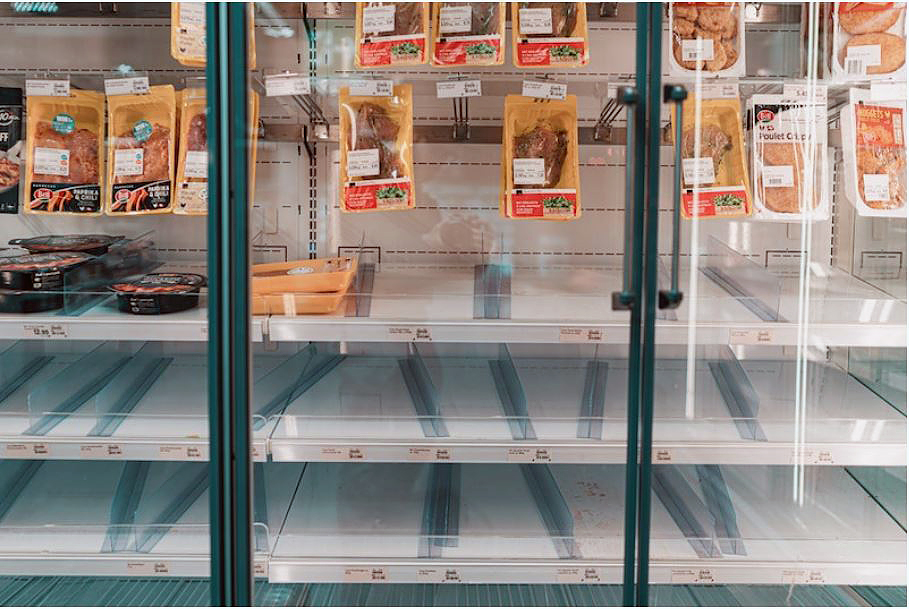If you’ve taken a recent trip to your local Trader Joe’s or Whole Foods, you might notice some empty store shelves and rising prices. And it’s not just big names that are experiencing rising prices and food shortages, nor is it a simple fix. Are we slowly returning to early pandemic days of grocery hoarding?
The good news? Probably not. A recent report by Avison Young finds promising signs of improvement in the grocery world.
We talked with Avison Young Capital Markets Leader Erik Foster about the complex issues impacting our food and grocery supply chains today, as well as the role industrial real estate plays in a grocery company’s ability to deliver goods.
Could you talk about the factors that are contributing to the shortages we’re seeing now?
Erik Foster: What we’re continuing to see in the supply chain, and especially in food, is congestion. The supply chains are in a state of flux. The producers of food are having trouble getting it to the manufacturers, and the manufacturers are having trouble getting it to the consumer. There are also employment issues, which are contributing to both the manufacturing and the distribution of that food.
It’s not just one thing. It’s a very wholistic problem around food and how it gets produced and then delivered to the consumer. The supply chain continues to be stretched.
So it’s still a tail-end pandemic issue?
Foster: It is. What’s also starting to impact the consumer is inflation. We’re seeing prices spike. I do believe that the suppliers of food and the end product are retooling how they work. Hopefully the issue will start to alleviate itself as the pandemic wanes, but it is still an issue.
Do you think things will get worse before they get better?
Foster: From an industrial distribution standpoint, I think that our point of view allows us to see signs of hope that people are solving for the larger issue. I believe the worst of it is behind us.
Are the factors contributing to these shortages in 2022 the same as those in 2020?
Foster: Yes. In 2020, food manufacturers and processors were still moving through existing inventory and making their way through. We then started to see these shortages creep up as these factors that we talked about earlier started to impact the supply chains down the line.
How difficult it is today for grocery stores to attract labor? Are they struggling to find enough workers?
Foster: They are. Those types of jobs are in high demand right now. We’re seeing what people are calling The Great Resignation, and many people are leaving the workforce. That is impacting both white- and blue-collar jobs. The grocery store retailer is having the same issue as the warehouse distribution facility and the pork or protein producer in Wisconsin. It’s the same issue up and down the continuum.
What do you think is the main reason for these workforce shortages?
Foster: It’s the demand that’s being put on those who are hiring, and it’s the lack of people, since they have left the workforce. When looking for an employer, people are looking for jobs that don’t require them to go into a facility. Many people are enjoying working from home. We are hearing about all of these things with clients and owners of real estate, and all of it is affecting the supply chain.
Do you foresee it evening out, and how soon?
Foster: We believe that industrial will still be a highly sought-after product by both tenants and investors in real estate. You have high demand by tenants, constraints on delivery of new product and historically good fundamentals that are in favor of landlords.
These three things are going to continue for the foreseeable future, and I would estimate it to be well over 12 months. Possibly 24. How that impacts employees within these facilities and the tenants, I think is yet to be determined.
ve taken a recent trip to your local Trader Joe’s or Whole Foods, you might notice some empty store shelves and rising prices. And it’s not just big names that are experiencing rising prices and food shortages, nor is it a simple fix. Are we slowly returning to early pandemic days of grocery hoarding?
The good news? Probably not. A recent report by Avison Young finds promising signs of improvement in the grocery world.
We talked with Avison Young Capital Markets Leader Erik Foster about the complex issues impacting our food and grocery supply chains today, as well as the role industrial real estate plays in a grocery company’s ability to deliver goods.
Could you talk about the factors that are contributing to the shortages we’re seeing now?
Erik Foster: What we’re continuing to see in the supply chain, and especially in food, is congestion. The supply chains are in a state of flux. The producers of food are having trouble getting it to the manufacturers, and the manufacturers are having trouble getting it to the consumer. There are also employment issues, which are contributing to both the manufacturing and the distribution of that food.
It’s not just one thing. It’s a very wholistic problem around food and how it gets produced and then delivered to the consumer. The supply chain continues to be stretched.




